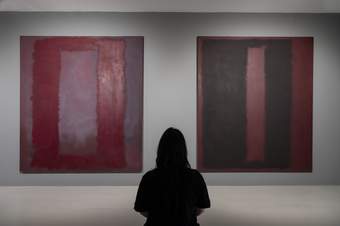Immerse yourself in Rothko's Seagram murals in this whole room display
For the first time, five of Mark Rothko’s Seagram murals are being shown at Tate St Ives.
In 1958, the American artist Mark Rothko accepted a commission to produce a series of large paintings for the Four Seasons restaurant in the Seagram Building, New York. He was interested in having a permanent setting where the works could always be shown as a group and in an immersive environment. He constructed a scaffold in his studio to match the exact dimensions of the restaurant and set to work.
In the Summer of 1959, Rothko took a break from working on the murals to travel to Europe with his family. He visited Cornwall, invited by artist Peter Lanyon, and met many like-minded artists including Alan Davie, Paul Feiler and Terry Frost, some who feature in Tate St Ives’s current displays.
Upon his return to the United States, Rothko decided that the restaurant would not be an appropriate location for his painting. He donated nine of them to Tate in 1969.
The Seagram murals were a significant departure for Rothko. The intense, bright colours of his earlier paintings gave way to maroon, dark red and black. Rothko wished to create a deep connection between the viewer and his paintings:
I am interested only in expressing basic human emotions – tragedy, ecstasy, doom
This one-room display includes five of the nine murals in the Tate collection. Presented, as the artist intended, in a single space with reduced light, these works offer a meditative conclusion to the exhibitions and displays at Tate St Ives.
Mark Rothko (1903–1970) was born in Russia. He emigrated to the US in 1913, and from 1925 lived and worked in New York.
Tate St Ives
Until 5 January 2025
Gallery admission required
Entry to both the display and the gallery is free for Tate Members, Locals' Pass holders and under 19s.

